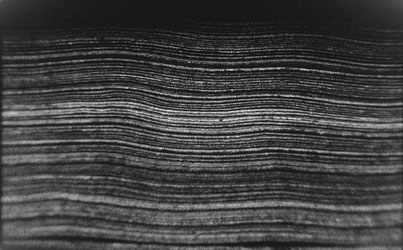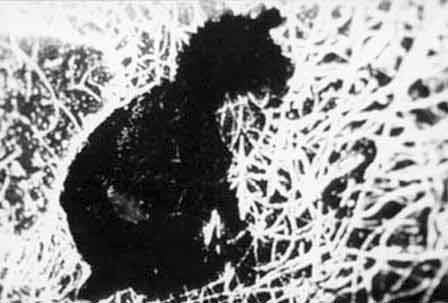
ARTIST IN FOCUS: David Gatten
Sunday 21 March 2010, 14:00. Film Plateau, Gent.
In the context of the Courtisane Festival 2010 (Gent, 17 – 21 March 2010)
For the past fifteen years American filmmaker David Gatten (US, 1971) has conducted a conscientious filmic investigation of the intersections between text and image, representation and abstraction, the emotional and the intellectual. Using traditional research methods as well as experimental film processes, he delves into the annals of private lives and public histories, in search for a cinematographic synthesis of biography, philosophy and poetry. His silent, handmade and rigorously structured films betray a certain influence of avant-garde filmmakers such as Stan Brakhage and Hollis Frampton, but at the same time reveal a strong personal identity, driven both by theoretical and spiritual considerations. Based on the writings of the same title from the library of William Byrd’s family in 18th-century Virginia, the series Secret History of the Dividing Line forms the core of his oeuvre. The handsome results of his search are, in his own words, “bookish films about letters and libraries and lovers and ghosts that are filled with words, some of which you can read.”
The first four episodes of the 9-part Secret History of the Dividing Line will be screened for the first time in Belgium as part of the thematic programme ‘Vital Signs’. Gatten’s first film Hardwood Process (1996) is also included in ‘Vital Signs’, whereas his recent work Journal & Remarks (2009) will be screened in the competition programme. At the invitation of Courtisane, David Gatten has prepared a selection of works and filmmakers that have been important to his practice.
Secret History of the Dividing Line: A True Account in Nine Parts
Secret History of the Dividing Line
US, 2002, 16mm, b&w, silent, 20’

“Paired texts as dueling histories; a journey imagined and remembered; 57 mileage markers produce an equal number of prospects. The first part of the Byrd cycle, the film focus on two texts by William Byrd, one published and official, the other secret and circulated privately. A torn timeline tells the history of the world and magnified, misaligned cement splices stand in for early 18th century landscapes”. (DG)
The Great Art of Knowing
US, 2004, 16mm, b&w, silent, 37’

“The fourth 16mm film in the Byrd project series. Taking as a point of departure the volume of the same title by the 17th century Jesuit priest Athanasius Kircher, this films attempts a peripatetic exploration of empiricism over the last 500 years. Additional material is drawn from Byrd’s papers, Leonardo da Vinci’s Codex on the Flight of Birds, as well as writings by David Hume and Jules-Etienne Marey”. (DG)
Moxon’s Mechanick Exercises, or, The Doctrine of Handy-Works Applied to the Art of Printing
US, 1999, 16mm, b&w, silent (18 fps), 26’

“This handmade film, with its images generated almost entirely from cellophane tape, is a meditation on the development of the printing press and its role in the spread of Christianity throughout Europe, the relationship between words and images, the poetics of translation, the fine line between the legible and the illegible, and the passage of the soul through the material world.” (DG)
The Enjoyment of Reading, Lost & Found
US, 2001, 16mm, b&w, silent (18 fps), 24’

“A closely watched candle and an invitation to the dance. William Byrd booms among his books while Evelyn keeps to a quiet window; the volunteer fire brigade sorts through the ashes and Isaac Goldberg tells it like it is. Who read what; when, and why?” (DG)
——————————————————————————————————————————————————————-


Essential Influences, emotional landscapes and memories of those who came before us
Compiled by David Gatten
“I had read all about the films before I ever saw any of them. By the time I did see them they had taken up permanent residence in my imagination. And when I saw them, I understood anew what it means to witness moving images: the images move – and the images are deeply moving. Hindle, Brakhage, Solomon, Fleming and Frampton: three different generations of American avant garde filmmakers, five very different approaches to that thing we call Cinema, but all films by filmmakers with a profound faith in the capacity of images to move us: aesthetically, emotionally, intellectually. The works of these five artists have intensely affected my own conception of the moving image and my own practice as a filmmaker. Frampton and Hindle were gone before I knew who they were but I was lucky enough to spend six years in conversation and correspondence with Brakhage. I went to graduate school to study with Fleming and learn from her just as she had learned from Hindle. Solomon I met by great good chance while in school and after several years of long-distance study and mentoring he has become a dearest friend and Colorado neighbor. This program of five films is a way for me – now fifteen years into my own filmmaking practice – to look back at the artists and works that shaped my vision during crucial and formative years – and continue to inspire me and expand my idea of what is possible in the art of the moving image”.
Will Hindle
Billabong
US, 1969, 16mm, colour, sound, 9′
“Hindle’s works are especially notable for their ability to generate overwhelming emotional impact almost exclusively from cinematic technique, not thematic content. Hindle has an uncanny talent for transforming spontaneous unstylized reality into unearthly poetic visions; as in Billabong, a wordless impresionistic ‘documentary’ about a boys’ camp.” (Gene Youngblood)
Stan Brakhage
Creation
US, 1979, 16mm, colour, silent, 17′
“… almost like the Earth itself – the green ice-covered rocks, the slicing feeling, the compressive feeling of the glaciers. The whole time I was watching I kept thinking that you were a master of the North, the arctic landscape – the dark red flowers in the dusky light, the deep blue light, the tall trees with the running mists, and Jane looking … the ice, the water, the moss, the golden light. A visual symphony ….” (Hollis Melton)
Phil Solomon
The Snowman
US, 1995, 16mm, colour, sound, 8′
“A meditation on memory, burial and decay … a belated kaddish for my father”. “It is the 19th century ’tissue of lies’ about childhood which Solomon rips open: his visual beauty, a biological beauty, is an encouragement to embrace this transformative mulch, this aesthetic compost, and to give up all commas ‘,’, of hesitation – to accept suffering even (as does most of the animal kingdom most stoically) and revel in the ‘fire of waters’ (as poet Robert Kelley put it) that we all are ….” (Stan Brakhage)
Michele Fleming
Left-Handed Memories
US, 1989, 16mm, colour, sound, 15′
“Like any worthwhile piece of art, Left-Handed Memories can be read several ways. Images of frames and framed materials recur. Pages of a dictionary flip by, and it is here that the viewer can see a reference to Will Hindle. Entry words echo his film titles – Billabong, Chinese Firedrill etc. A soft-focus female nude, reminiscent of an Edward Weston photograph, becomes increasingly scratched as the footage runs, a memento mori of the plastic material itself. Much, the film tells us, is beautiful, and much will be forgotten.” (Tom Whiteside)
Hollis Frampton
Gloria!
US, 1979, 16mm, colour, sound, 9′
“In Gloria! Frampton juxtaposes nineteenth-century concerns with contemporary forms through the interfacing of a work of early cinema with a videographic display of textual material. These two formal components (the film and the texts) in turn relate to a nineteenth-century figure, Frampton’s maternal grandmother, and to a twentieth-century one, her grandson (filmmaker Frampton himself). In attempting to recapture their relationship, Gloria! becomes a somewhat comic, often touching meditation on death, on memory and on the power of image, music and text to resurrect the past.” (Bruce Jenkins)